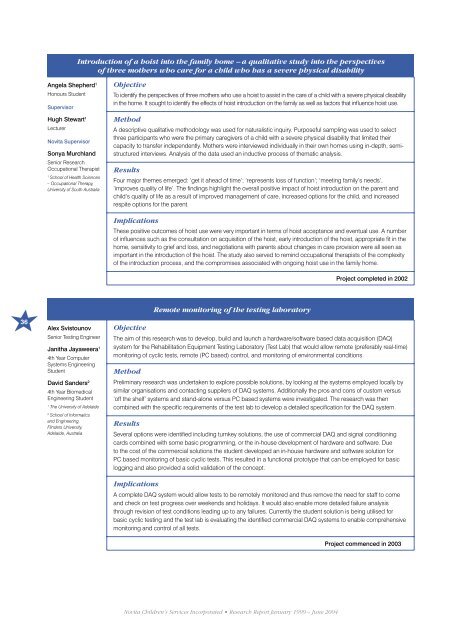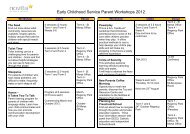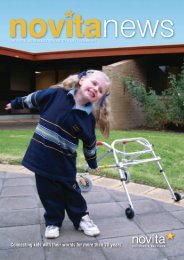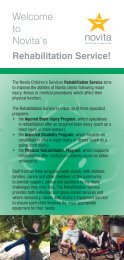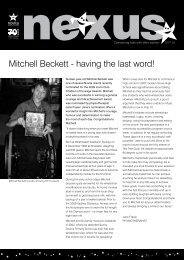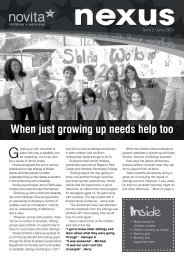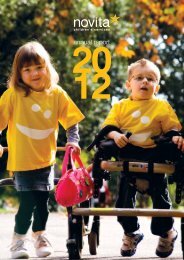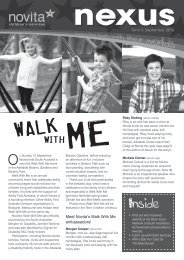Novita Research Report January 1999 - Novita Children's Services
Novita Research Report January 1999 - Novita Children's Services
Novita Research Report January 1999 - Novita Children's Services
You also want an ePaper? Increase the reach of your titles
YUMPU automatically turns print PDFs into web optimized ePapers that Google loves.
Introduction of a hoist into the family home – a qualitative study into the perspectives<br />
of three mothers who care for a child who has a severe physical disability<br />
Angela Shepherd 1<br />
Honours Student<br />
Supervisor<br />
Hugh Stewart 1<br />
Lecturer<br />
<strong>Novita</strong> Supervisor<br />
Sonya Murchland<br />
Senior <strong>Research</strong><br />
Occupational Therapist<br />
1<br />
School of Health Sciences<br />
– Occupational Therapy,<br />
University of South Australia<br />
Objective<br />
To identify the perspectives of three mothers who use a hoist to assist in the care of a child with a severe physical disability<br />
in the home. It sought to identify the effects of hoist introduction on the family as well as factors that influence hoist use.<br />
Method<br />
A descriptive qualitative methodology was used for naturalistic inquiry. Purposeful sampling was used to select<br />
three participants who were the primary caregivers of a child with a severe physical disability that limited their<br />
capacity to transfer independently. Mothers were interviewed individually in their own homes using in-depth, semistructured<br />
interviews. Analysis of the data used an inductive process of thematic analysis.<br />
Results<br />
Four major themes emerged: ‘get it ahead of time’; ‘represents loss of function’; ‘meeting family’s needs’,<br />
‘improves quality of life’. The findings highlight the overall positive impact of hoist introduction on the parent and<br />
child’s quality of life as a result of improved management of care, increased options for the child, and increased<br />
respite options for the parent.<br />
Implications<br />
These positive outcomes of hoist use were very important in terms of hoist acceptance and eventual use. A number<br />
of influences such as the consultation on acquisition of the hoist, early introduction of the hoist, appropriate fit in the<br />
home, sensitivity to grief and loss, and negotiations with parents about changes in care provision were all seen as<br />
important in the introduction of the hoist. The study also served to remind occupational therapists of the complexity<br />
of the introduction process, and the compromises associated with ongoing hoist use in the family home.<br />
Project completed in 2002<br />
36<br />
Alex Svistounov<br />
Senior Testing Engineer<br />
Janitha Jayaweera 1<br />
4th Year Computer<br />
Systems Engineering<br />
Student<br />
David Sanders 2<br />
4th Year Biomedical<br />
Engineering Student<br />
1<br />
The University of Adelaide<br />
2<br />
School of Informatics<br />
and Engineering,<br />
Flinders University,<br />
Adelaide, Australia<br />
Objective<br />
Remote monitoring of the testing laboratory<br />
The aim of this research was to develop, build and launch a hardware/software based data acquisition (DAQ)<br />
system for the Rehabilitation Equipment Testing Laboratory (Test Lab) that would allow remote (preferably real-time)<br />
monitoring of cyclic tests, remote (PC based) control, and monitoring of environmental conditions.<br />
Method<br />
Preliminary research was undertaken to explore possible solutions, by looking at the systems employed locally by<br />
similar organisations and contacting suppliers of DAQ systems. Additionally the pros and cons of custom versus<br />
‘off the shelf’ systems and stand-alone versus PC based systems were investigated. The research was then<br />
combined with the specific requirements of the test lab to develop a detailed specification for the DAQ system.<br />
Results<br />
Several options were identified including turnkey solutions, the use of commercial DAQ and signal conditioning<br />
cards combined with some basic programming, or the in-house development of hardware and software. Due<br />
to the cost of the commercial solutions the student developed an in-house hardware and software solution for<br />
PC based monitoring of basic cyclic tests. This resulted in a functional prototype that can be employed for basic<br />
logging and also provided a solid validation of the concept.<br />
Implications<br />
A complete DAQ system would allow tests to be remotely monitored and thus remove the need for staff to come<br />
and check on test progress over weekends and holidays. It would also enable more detailed failure analysis<br />
through revision of test conditions leading up to any failures. Currently the student solution is being utilised for<br />
basic cyclic testing and the test lab is evaluating the identified commercial DAQ systems to enable comprehensive<br />
monitoring and control of all tests.<br />
Project commenced in 2003<br />
<strong>Novita</strong> Children’s <strong>Services</strong> Incorporated • <strong>Research</strong> <strong>Report</strong> <strong>January</strong> <strong>1999</strong> – June 2004


